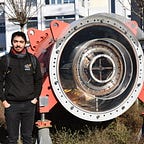Mobility for the most vulnerable
The importance of everyone being able to get everywhere with ease.
Everyone must have a way to get everywhere with ease. Only then can we guarantee the quality of life that people individually and societies collectively deserve, especially in the cities where there’s been, and will continue to be, an increase of population until 2050.
In my eyes, there are two main ways of solving this problem:
- A collaborative effort to develop non-urban areas in countries where there’s a high density of population in cities;
- Improving our cities’ systems in a way so that it will be easier, healthier, and safer to travel. Cities will be at their prime when they are adapted for everyone, and mobility should be a right for every citizen.
La ville du quart d’heure
All basic needs should be at a 15-minute range by foot or bike from your home: health, education, shops, markets, cultural life, sports, and parks. As cities, we need to rethink our square meters. How can we transform an office space while it’s been unused during the evening and night? Should it be a place to do yoga classes? Or could we use those computers to have a senior university, where classes take place, not only saving space but also resources? The 15-minute city is a must in a circular economy.
This is a human-city focused model; it has a strong emphasis on the local aspect, which creates neighbourhood bonds.
Be aware that this strategy is not “against” cars or other motorised vehicles; it’s in favour of people. It’s highly inefficient to let cars inside of cities and have speed limits of around 30km/h combined with traffic lights, not only because of the time spent crossing the city but also the price and pollution created.
Paris Transformation
The mayor of Paris, Anne Hidalgo, has taken the message from Carlos Moreno, a professor of complex systems and innovation at the University of Paris 1, on this topic. There are measures to transform Paris, a historic centre full of cars and tourists, into a city for people with services available at every corner.
Of course, this has to be achieved through reinforcement of public transportation, rethinking of services and spaces.
Inconveniences
This scenario for many is a great inconvenience, in several conversations I had in the past it comes back to the following questions: So I can’t go to work in the comfort of my car? How do I take my kids to school? It’s not safe enough for them.
It’s always a though to make a decision based on another person’s well being and the comfort zone, but I challenge you to view it from a specific standpoint: The most vulnerable.
We should take into consideration the elders, children and people who live with a disability whether that would be physical or mental. We have to plan our cities around them, not only thinking about their safety but also their health, mobility is one of our societies great benefits, and we need to guarantee it.
“About 15% of the world’s population lives with some form of disability, of whom 2–4% experience significant difficulties in functioning.” WHO
Those are the most vulnerable of our society, a city-model like the “La ville du quart d’heure” encompasses these needs and more. For the rest of us, a 15-minute walk or bike ride will not only save money but also improve our health. For the impact we have, the 15-minute city considerably reduces CO2 emissions and betters the ecology of cities.
Let’s hike this path and demand the best from our cities.
